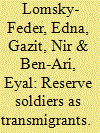| Srl | Item |
| 1 |
ID:
104077


|
|
|
|
|
| Publication |
2011.
|
| Summary/Abstract |
The Israeli reservists played a major role in the protest movements that developed after the 1973 War and the First Lebanon War (1982-85). In other cases, debates about moral and political issues within the Israeli political system included petitions and rallies conducted by groups of reservists. How can scholars explain the special standing of the Israeli reservists within Israeli society? Why, during the 1970s and the 1980s, did the protests of the reservists lead to significant changes in the Israeli political and social arena, while this was not the case in the aftermath of the Second Lebanon War? The article explores these dilemmas by presenting different facets of the Israeli reserve army and its role in civil-military relations in Israel. The rationale for the establishment of the reserve army in Israel is discussed and is followed by an analysis of the changes the reserve forces have gone through since the establishment of the state.
|
|
|
|
|
|
|
|
|
|
|
|
|
|
|
|
| 2 |
ID:
082696


|
|
|
|
|
| Publication |
2008.
|
| Summary/Abstract |
This article suggests a new perspective for examining the particular social and organizational characteristics of military reserves forces and the special experiences of serving in the reserves. To illustrate the unique social position of reservists, the authors develop a theoretical model that likens them to transmigrants. Accordingly, the authors suggest that society may benefit from looking at reserves both as sorts of social and organizational hybrids or amalgams-they are soldiers and civilians, they are outside yet inside the military system, and are invested in both spheres-and as continual migrants journeying between military and civilian spheres. The authors end by suggesting that it may be fruitful to study three segments of the military, each of which has its own dynamics: regulars, conscripts, and reserves. This differentiation allows society to examine different patterns of motivation, cohesion, political commitment and awareness, and long-term considerations that characterize each segment
|
|
|
|
|
|
|
|
|
|
|
|
|
|
|
|